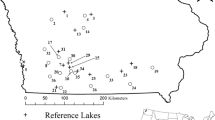Abstract
Lake restoration projects require substantial monitoring. Primary purposes are to assess a lake problem, determine its causes and design or develop a corrective program. Hundreds of these lake monitoring projects have been initiated in the United States over the past decade. A number of field limnological activities can be improved to make the monitoring results more applicable to the objectives of a project. This paper discusses twenty of the most common limnology procedures that may go awry in applied limnology and makes suggestions, alternatives or improved field and project procedures. Expenditures may be reduced, but more important can be an increased use capability of the information for the scientific and engineering needs of a lake restoration effort.
Similar content being viewed by others
References
American Public Health Association et al.: 1976, Standard Methods for Examination of Water and Wastewater, Amer. Pub. Health Assoc., Wash., D.C.
Birge, E. A. and Juday, C.: 1911, The Inland Lakes of Wisconsin: The Dissolved Gases of the Water and their Biological Significance. Bull. 22, Wis. Nat. Hist. Surv., Madison.
Blackburn, R. D. et al.: 1968, ‘Ecology of Submersed Aquatic Weeds in South Florida Canals’, Weed Sci. 16, 261.
Breen, C. M. et al.: 1976, ‘A Quantitative Sampler for Aquatic Macrophytes’, Jour. Limnol. Soc. str. Afr. 2, 59.
Carlander, K. D.: 1950, Handbook of Freshwater Fishery Biology, Brown, Dubuque, Iowa.
Carlander, K. D.: 1953. Handbook of Freshwater Fishery Biology, Brown, Dubuque, Iowa. First supplement.
Carlander, K. D.: 1978. Handbook of Freshwater Fishery Biology, Brown, Dubuque, Iowa. Volume 2.
Committee on Government Operations: 1968, ‘Views of the Governors on Saving America's Small Lakes’, House report No. 1571, U.S. Govt. Print. Office, Wash., D.C.
Frey, D. G.: 1964, ‘Remains of Animals in Quartenary Lake and Bog Sediments and their Interpretation’, Ergeb. Limnol. 2, 1.
Frey, D. G.: 1974, ‘Paleolimnology’, Mitt. Int. Ver. Theor. Anger. Limnol. 20, 95.
Forsberg, C.: 1959, ‘Quantitative Sampling of Subaquatic Vegetation’, Oikos. 10, 233.
Forsberg, C.: 1960, ‘Subaquatic Macrovegetation in Osbysjon, Djurholm’, Oikos. 11, 183.
Jervis, R. A.: 1969, ‘Primary Production in the Freshwater Marsh Ecosystem of Troy Meadows, New Jersey’, Bull. Torrey Bot. Club. 96, 209.
Keup, L. E.: 1979, ‘Fisheries in Lake Restoration’, Fisheries 4, 7.
Keup, L. E. and Hicks, D. B.: 1978, ‘Rooted Aquatic Plants’, in The Freshwater Potomac Aquatic Communities and Environmental Stress Symposium Proceedings, Interstate Commission Potomac River Basin, Rockville, Maryland.
Laevastu, T.: 1965, Manual of Methods in Fisheries Biology (9 fasicales) FAO, Rome.
Lagler, K. F.: 1956, Freshwater Fishery Biology, Brown, Dubuque, Iowa.
Library of Congress: 1973, A Legislative History of the Water Pollution Control Act Amendments of 1972, Vol 2, Govt. Print. Office, Wash., D.C.
Mackenthun, K. M.: 1969, The Practice of Water Pollution Biology, U.S. Govt. Print. Office, Wash., D.C.
Mackenthun, K. M.: 1973. Toward a Cleaner Aquatic Environment, U.S. Govt. Print Office, Wash., D.C.
Martin, A. C. and Uhler, F. M.: 1939, Food of Game Ducks in the United States and Canada, Bull 634, U.S. Dept. of Agri.
National Academy of Sciences and National Academy of Engineering: 1973, Water Quality Criteria, 1972, U.S. Govt. Print. Office, Wash., D.C.
Naumann, E.: 1919, ‘Nagra sympunkter angaende planktons okologie; med sarskild honsym till fytoplakkton’. Svensk. Bot. Tidskr. 13, 129.
Rounsefell, G. A. and Everhart, W. H.: 1953, Fisheries Science: Its Methods and Applications. Wiley, N.Y.
Scott, M.: 1979, Applied Limnology in the State of Maine, pp. 21–24 in LAKE RESTORATION. U.S. Environmental Protection Agency, Washington, D.C.
Taylor, W. D. et al.: 1979, Phytoplankton Water Quality Relationships in U.S. Lakes, Part IV: The Common Phytoplankton Genera from Eastern and Southeastern Lakes, Working Paper # 710. U.S. Environmental Proctection Agency, Las Vegas, Nevada.
Thienemann, A.: 1928, ‘Der Sauerstoff im eutrophen und oligothrophen Seen’, Die Binnengewasser, Vol 4, Schwiezerbartsche Verlagsbuchandlung, Stuttgart.
U.S. Geological Survey: 1972, Recommended methods for water data acquisition, U.S. Dept. of Interior, Wash., D.C.
Weber, C. J. (ed.): 1973, Biological Field and Laboratory Methods for Measuring the Quality of Surface Waters and Effluents; U.S. Environmental Protection Agency, Cincinnati, Ohio.
Welch, P.S.: 1948, Limnological Methods, Blakiston. Chiladelphia.
Westlake, D. F.: 1966, ‘The Biomass and Productivity of Glyceria maxima. I, Seasonal Changes in Biomass’. Jour. Ecol. 54, 745.
Wetzel, R. H.: 1975, Limnology, Saunders, Philadelphia.
Author information
Authors and Affiliations
Rights and permissions
About this article
Cite this article
Keup, L.E. Monitoring lakes for restoration. Environ Monit Assess 5, 339–360 (1985). https://doi.org/10.1007/BF00399463
Received:
Issue Date:
DOI: https://doi.org/10.1007/BF00399463




